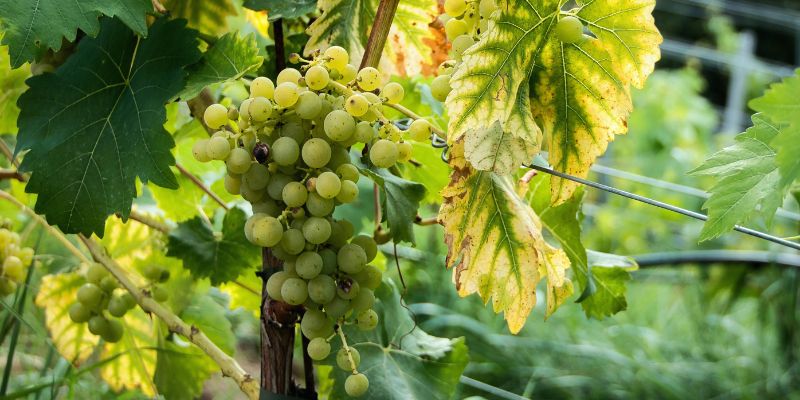Introductory Wine Course
More on Chardonnay
Chardonnay's global dominance stems from its remarkable adaptability and responsiveness to winemaking technique, making it essential to understand this variety's nuances beyond basic recognition. This grape transforms dramatically based on climate, soil, and cellar decisions, producing everything from steely Chablis to opulent Napa bottlings, and from crisp Champagne base wines to rich white Burgundies. Mastering Chardonnay means recognizing how malolactic fermentation, oak treatment, and regional expression create vastly different wine styles from genetically identical fruit. This deeper knowledge enables more precise communication about what distinguishes a white Burgundy from simply a wine made from Chardonnay grapes.
Flavor Profile and Malolactic Fermentation's Impact
Chardonnay's natural flavor profile centers on green apple, lemon, and pear in cool climates, shifting toward stone fruits like peach and nectarine in moderate conditions, and expressing tropical notes of pineapple, mango, and banana in warmer regions. The grape also shows mineral, flint, or chalk characteristics depending on soil composition, particularly in limestone-rich sites. Malolactic fermentation fundamentally alters Chardonnay's sensory profile by converting sharp malic acid into softer lactic acid, the same compound found in milk and butter. This biological process, which occurs after primary alcoholic fermentation, reduces perceived acidity while creating diacetyl, the compound responsible for buttery, creamy aromas and a rounder mouthfeel. Winemakers control whether malolactic fermentation occurs, using it selectively to achieve desired styles. Full malolactic fermentation produces the classic creamy, buttery California Chardonnay, while blocking it entirely preserves bright acidity and pure fruit expression. Some producers employ partial malolactic fermentation, allowing only a portion of the wine to undergo the process before blending, creating middle-ground styles. This technical decision represents one of the most significant stylistic choices in Chardonnay production, dramatically affecting texture, aroma, and aging potential.
Chardonnay is at the mercy of the winemaker in most vintages. It is the grape that shows the producer's intentions best, with the choices made by the winemaker being directly correlated to the aroma and flavor of the finished product.
Chardonnay's Range: Champagne to White Burgundy
Chardonnay plays a crucial role in Champagne production, where it contributes elegance, finesse, and aging potential to both blended and single-variety bottlings. Blanc de Blancs Champagne, made entirely from Chardonnay, showcases the grape's ability to provide citrus precision, mineral complexity, and delicate structure that develops toasty, brioche-like characteristics through extended aging on lees. The Côte des Blancs, particularly villages like Cramant and Le Mesnil-sur-Oger, produces Chardonnay base wines with remarkable acidity and tension that benefit from the traditional method's transformative effects. White Burgundy represents Chardonnay's apex of terroir expression, where the grape reveals subtle differences between villages and vineyards with remarkable clarity. Chablis in northern Burgundy produces lean, mineral-driven wines with green apple and oyster shell notes, often without oak influence, emphasizing the Kimmeridgian limestone soils. Moving south, the Côte de Beaune villages of Meursault, Puligny-Montrachet, and Chassagne-Montrachet create richer styles with stone fruit, hazelnut, and buttered toast characteristics, typically with judicious oak aging. These wines balance ripeness with tension, showing both generosity and restraint, and often require years to integrate their components and reveal their full complexity.

Understanding Chardonnay Versus White Burgundy
The distinction between generic Chardonnay and white Burgundy extends beyond geography to encompass philosophy, technique, and terroir expression. Chardonnay as a varietal wine, particularly from New World regions, emphasizes fruit ripeness, oak influence, and immediate approachability. These wines often show higher alcohol, fuller body, pronounced oak-derived flavors like vanilla and toast, and complete malolactic fermentation creating buttery textures. The grape variety dominates the sensory experience, with site characteristics playing a supporting role. White Burgundy, conversely, prioritizes place over variety, with winemaking designed to reveal terroir rather than mask it. Burgundian producers typically use older oak barrels that impart less obvious wood flavor, practice partial or no malolactic fermentation to preserve acidity, and employ longer aging that allows wine components to integrate naturally. The resulting wines show greater minerality, more restrained fruit, higher acidity, and structural complexity that unfolds over years or decades. White Burgundy demands food and contemplation, while many Chardonnays offer immediate pleasure. Understanding this difference proves critical when guiding customers toward appropriate selections based on their preferences, meal pairings, and drinking timelines.
Distinguishing between Chardonnay as a grape and white Burgundy as a place-driven wine style enables more sophisticated recommendations and accurate descriptions. Recognizing how malolactic fermentation, oak treatment, and regional philosophy shape Chardonnay's expression allows you to communicate meaningfully about style differences, from Champagne's precision through Burgundy's complexity to New World's approachability. This knowledge proves essential when selling wine, matching bottles to customer preferences, and building trust through accurate, nuanced guidance that respects both the wine and the person choosing it.